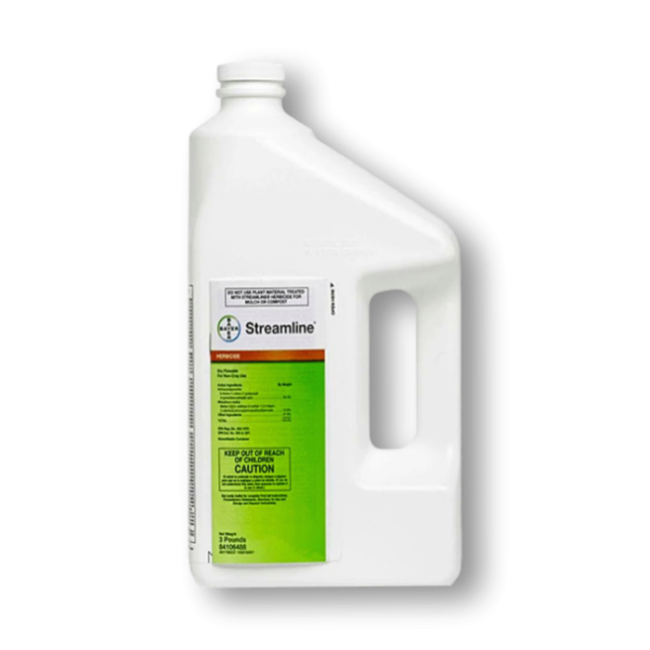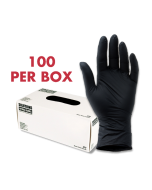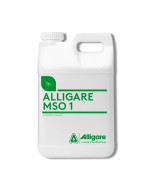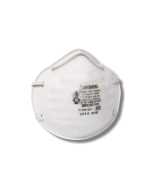Gain access to personalized product screening, the best pricing, rewards, and more!
Streamline Herbicide
Streamline Herbicide is a specialized pre- and post-emergent herbicide that easily manages a broad spectrum of broadleaf weeds, brush, and woody plants in non-agricultural and industrial sites.
10/31/25
Streamline Herbicide, manufactured by Bayer, is a professional pre- and post-emergent water-dispersable granule herbicide designed especially for selective vegetation management.
It combines two active ingredients in a unique formulation to effectively control undesirable vegetation, such as cocklebur, clover, and more while promoting the maintenance of clear and safe terrain.
Streamline Herbicide archives dependable control of undesirable broadleaf weeds and woody plants, leading to safer and more aesthetically pleasing non-crop areas. The formula becomes rainfast after 4 hours, ensuring effective protection even after light rain.
Tools Needed
It can be applied with a backpack sprayer or spray rig.
How to Use
- Step 1: Determine how much Streamline Herbicide to use by measuring the square footage of the treatment area. Find the square footage by measuring the treatment area's length and width in feet, then multiplying them together (length X width = square footage). For acreage, take the square footage and divide it by one acre (square footage / 43,560 sq. ft. = acres). For spot treatments, use 2.3 oz. of Streamline Herbicide with 5 gallons of water. Spot application rates are based on 1 gallon of spray solution covering 1750 square feet. Do not apply more than 11.5 ounces product per broadcast acre per year as a result of broadcast, spot or repeat applications. Refer to the product label for specific application rates and restrictions.
- Step 2: Fill the sprayer tank with half the amount of water, add the proper amount of product, then pour in the remaining half of the water. Close the tank lid and shake until well-mixed.
- Step 3: When making broadcast applications, apply near the tops of the brush plants in a light drizzle pattern. The spray solution must reach the crown of the plants and trickle down into the canopy. Use sufficient spray volume to thoroughly and uniformly wet foliage and stems but don't over apply causing excessive run-off.
Where to Use
Streamline Herbicide can be used on private, public, and military lands as follows: uncultivated non-agricultural areas (such as airports, highways, railroad and utility rights-of-way, sewage disposal areas, etc.); uncultivated agricultural areas - non-crop producing (such as farmyards, fuel storage areas, fence rows, non-irrigation ditch banks, barrier strips, etc.); industrial sites - outdoor (such as lumberyards, pipeline, and tank farms, etc.) and natural areas (such as wildlife management areas, wildlife openings, wildlife habitats).
This product may be applied to terrestrial non-crop sites that contain areas of temporary surface water caused by collection of water, in equipment ruts, or in other depressions created by management activities. It is permissible to treat intermittently flooded low lying sites, seasonally dry flood plains and transitional areas between upland and lowland sites when no water is present.
Treating marshes, swamps, and bogs after water recedes and seasonally dry flood deltas is also permissible. Streamline Herbicide may be applied up to the water's edge. Do not apply directly to water
When to Use
Apply during periods when target weeds are actively growing.
Avoid applications when rainfall is expected within the next 48 hours after application.
Safety Information
Streamline Herbicide is safe for people and pets when applied according to the product label instructions. Always wear the proper personal protective equipment (PPE) when mixing and applying this product.
Keep people and pets out of the treated area until the spray completely dries.
Special Considerations
Injury or loss of desirable trees or vegetation may result if Streamline Herbicide is applied on or near desirable trees or vegetation, on areas where their roots extend, or in locations where the treated soil may be washed or moved into contact with their roots.
| Availability | Online |
| Restricted Use | No |
| Shipping Restrictions * = not registered** = restricted use | 3 Pound: AK*, AR*, AZ*, CA*, CO*, DC*, DE*, FL*, GA*, HI*, IL*, LA*, MA*, MD*, ME*, MI*, MN*, MO*, MT*, NC*, NE*, NH*, NJ*, NM*, NV*, NY*, OH*, OK*, OR*, PA*, SC*, SD*, TN*, TX*, UT*, VA*, VT*, WA*, WI*, WY* |
| Brand | BAYER CROP SCIENCE |
| Keith's Pro Tips | "Before replanting after a Streamline Herbicide application, we recommend a field bioassay. To conduct a field bioassay, grow to maturity test strips of the crop you plan to grow the following year. The test strips must cross the entire field including knolls and low areas. Crop response to the field bioassay will indicate whether or not to plant the crops grown in the test strips. If no crop injury (such as poor germination, stunting, or chlorosis, malformation, or necrosis of leaves) or yield loss is evident from the crops grown in the test strips, the intended rotational crop may be planted. If herbicide symptoms or yield loss is observed do not plant the crop." |
| Product Drawbacks | Injury to crops or desirable vegetation may result if treated soil is washed, blown or moved onto land used to produce crops or land containing desirable vegetation. |
| Target Pests | Annual Sowthistle, Annual Sowthistle (Preemergence), Ash, Ash (Preemergence), Aspen, Aster, Aster (Preemergence), Baccharis, Bahiagrass, Bahiagrass (Preemergence), Beebalm, Bitter Sneezeweed, Bittercress, Bittercress (Preemergence), Black Henbane, Black Locust, Black Spruce, Blackberry, Blackberry (Preemergence), Blackeyedsusan, Blackeyedsusan (Preemergence), Blue Mustard, Blue Mustard (Preemergence), Boxelder, Boxelder (Preemergence), Broadleaf Weeds, Broadleaf Weeds (Preemergence), Broom Snakeweed, Brush, Buckhorn Plantain, Buckhorn Plantain (Preemergence), Bull Thistle, Bull Thistle (Preemergence), Burr Buttercup, Burr Buttercup (Preemergence), Camelthorn, Canada Thistle, Canada Thistle (Preemergence), Catalpa, Cherry, Cherry (Preemergence), Chicory, Chicory (Preemergence), Chinese Tallowtree, Chinese Tallowtree (Preemergence), Clover (Preemergence), Cocklebur, Cocklebur (Preemergence), Cogongrass, Common Chickweed, Common Chickweed (Preemergence), Common Crupina, Common Groundsel, Common Groundsel (Preemergence), Common Mullein, Common Mullein (Preemergence), Common Purslane, Common Purslane (Preemergence), Common Ragweed, Common Ragweed (Preemergence), Common Sowthistle, Common Sowthistle (Preemergence), Common Sunflower, Common Sunflower (Preemergence), Common Tansy, Common Yarrow, Common Yarrow (Preemergence), Conical Catchfly, Conical Catchfly (Preemergence), Corn Cockle, Corn Cockle (Preemergence), Cottonwood, Cow Cockle, Cow Cockle (Preemergence), Crownvetch, Curly Dock, Curly Dock (Preemergence), Dalmatian Toadflax, Dandelion, Dandelion (Preemergence), Dewberry, Dewberry (Preemergence), Diffuse Knapweed, Dogfennel, Dogfennel (Preemergence), Dyers Woad, Eastern Red Cedar, Elderberry, Elderberry (Preemergence), Elm, Elm (Preemergence), False Chamomile, False Chamomile (Preemergence), Field Bindweed, Field Bindweed (Preemergence), Field Pennycress, Field Pennycress (Preemergence), Fir, Flixweed, Flixweed (Preemergence), Garlic Mustard, Goldenrod, Goldenrod (Preemergence), Gorse, Greasewood, Gumweed, Gumweed (Preemergence), Hackberry, Halogeton, Hawthorn, Hawthorn (Preemergence), Henbit, Henbit (Preemergence), Hoary Cress, Hoary Cress (Preemergence), Honeysuckle, Honeysuckle (Preemergence), Horseweed, Horseweed (Preemergence), Houndstongue, Huisache, Kochia, Kochia (Preemergence), Kudzu, Kudzu (Preemergence), Lambsquarters, Lambsquarters (Preemergence), Larkspur, Leafy Spurge, Leafy Spurge (Preemergence), Lespedeza, Lespedeza (Preemergence), Lupine, Lupines (Preemergence), Marestail, Marestail (Preemergence), Maximilian Sunflower, Mesquite, Minerslettuce, Minerslettuce (Preemergence), Mulberry, Mulberry (Preemergence), Multiflora Rose, Multiflora Rose (Preemergence), Musk Thistle, Musk Thistle (Preemergence), No Pest, Oak, Oak (Preemergence), Osageorange, Oxeye Daisy, Oxeye Daisy (Preemergence), Pennsylvania Smartweed, Pennsylvania Smartweed (Preemergence), Perennial Broadleaf Weeds, Perennial Pepperweed, Persimmon Common, Plains Coreopsis, Plantain, Plantain (Preemergence), Plumeless Thistle, Poison Hemlock, Poison Hemlock (Preemergence), Poison Ivy, Poison Ivy (Preemergence), Prickly Lettuce, Prickly Lettuce (Preemergence), Prostrate Knotweed, Prostrate Knotweed (Preemergence), Purple Loose Strife, Red Maple, Red Maple (Preemergence), Redroot Pigweed, Redroot Pigweed (Preemergence), Redstem Filaree, Redstem Filaree (Preemergence), Rosering Gaillardia, Rough Fleabane, Rough Fleabane (Preemergence), Rush Skeletonweed, Russian Knapweed, Russian Knapweed (Preemergence), Russian Thistle, Russian Thistle (Preemergence), Salmonberry, Salsify, Salsify (Preemergence), Sassafras, Sassafras (Preemergence), Scotch Thistle, Scouringrush, Seaside Arrowgrass, Shepherdspurse, Shepherdspurse (Preemergence), Silver Maple, Smallseed Falseflax, Smooth Pigweed, Smooth Pigweed (Preemergence), Snowberry, Sorrel, Sorrel (Preemergence), Spotted Knapweed, St. Johnswort, St. Johnswort (Preemergence), Sulphur Cinquefoil, Sumac, Sumac (Preemergence), Sweetclover, Sweetclover (Preemergence), Sycamore, Tall Ironweed, Tall Larkspur, Tansy Ragwort, Tansy Ragwort (Preemergence), Tansymustard, Tansymustard (Preemergence), Tarweed Fiddleneck, Tarweed Fiddleneck (Preemergence), Teasel, Thimbleberry, Treacle Mustard, Treacle Mustard (Preemergence), Tree-Of-Heaven, Tumble Mustard, Tumble Mustard (Preemergence), Tupelo, Turkey Mullein, Turkey Mullein (Preemergence), Vines, Vines (Preemergence), Western Ragweed, Western Ragweed (Preemergence), Western Salsify, White Spruce, Whitetop, Whitetop (Preemergence), Wild Carrot, Wild Carrot (Preemergence), Wild Garlic, Wild Garlic (Preemergence), Wild Grape, Wild Grape (Preemergence), Wild Iris, Wild Lettuce, Wild Lettuce (Preemergence), Wild Mustard, Wild Mustard (Preemergence), Wild Parsnip, Wild Parsnip (Preemergence), Wild Rose, Wild Rose (Preemergence), Willow, Willow (Preemergence), Woolly Croton, Woolly Croton (Preemergence), Yankeeweed, Yellow Poplar, Yellow Poplar (Preemergence), Yellow Starthistle, Yellow Starthistle (Preemergence), and Yellow Toadflax. |
| Application Equipment | Backpack Sprayer, Spray Rig |
| Application Methods | Broadcast Spray |
| Active Ingredient | Aminocyclopyrachlor 39.5% Metsulfuron methyl 12.6% |
| Product Type | Herbicide |
| Formulation | Water Dispersible Granule (WDG) |
| Application Rate | For spot treatments, use 2.3 oz. of Streamline Herbicide with 5 gallons of water. Spot application rates are based on 1 gallon of spray solution covering 1750 square feet. |
| Shelf Life | Streamline Herbicide will last for 3 years when stored in a cool, dry place. |
| Yield | 3 lbs. of Streamline Herbicide will cover 4 acres. |
| Use Sites | Outdoors |
| Time to Kill | The effects of Streamline Herbicide may be seen on plants from within a few hours to a few days. Death of treated broadleaf plants may require several more weeks and up to several months for some woody plant species. |
| Comparable Products | Rometsol Herbicide |
| Use Caution With | St Augustine |
| EPA Registration # | 432-1570 |
| Restricted Use | No |
|---|---|
| Shipping Restrictions | AK, AR, AZ, CA, CO, DC, DE, FL, GA, HI, IL, LA, MA, MD, ME, MI, MN, MO, MT, NC, NE, NH, NJ, NM, NV, NY, OH, OK, OR, PA, SC, SD, TN, TX, UT, VA, VT, WA, WI, WY |
| Availability | Online |
| Signal Word | CAUTION |
| Keith's Pro Tip | "Before replanting after a Streamline Herbicide application, we recommend a field bioassay. To conduct a field bioassay, grow to maturity test strips of the crop you plan to grow the following year. The test strips must cross the entire field including knolls and low areas. Crop response to the field bioassay will indicate whether or not to plant the crops grown in the test strips. If no crop injury (such as poor germination, stunting, or chlorosis, malformation, or necrosis of leaves) or yield loss is evident from the crops grown in the test strips, the intended rotational crop may be planted. If herbicide symptoms or yield loss is observed do not plant the crop." |
| Time to Kill | The effects of Streamline Herbicide may be seen on plants from within a few hours to a few days. Death of treated broadleaf plants may require several more weeks and up to several months for some woody plant species. |
| Chemical Type | Herbicide |
| Formulation | Water Dispersible Granule (WDG) |
| Application Methods | Broadcast Spray |
| Product Drawbacks | Injury to crops or desirable vegetation may result if treated soil is washed, blown or moved onto land used to produce crops or land containing desirable vegetation. |
| Active Ingredient | Aminocyclopyrachlor 39.5% Metsulfuron methyl 12.6% |
| Application Equipment | Backpack Sprayer, Spray Rig |
| Mix Rate | For spot treatments, use 2.3 oz. of Streamline Herbicide with 5 gallons of water. Spot application rates are based on 1 gallon of spray solution covering 1750 square feet. |
| Use Sites | Outdoors |
| Yield | 3 lbs. of Streamline Herbicide will cover 4 acres. |
| EPA Registration No. | 432-1570 |
| Shelf Life | Streamline Herbicide will last for 3 years when stored in a cool, dry place. |
| Comparable Products | Rometsol Herbicide |
| Children or pets? | No |
| Property Characteristics | None |
*Price does not include freight. We guarantee our rate plus shipping will be less than anyone else's price.














